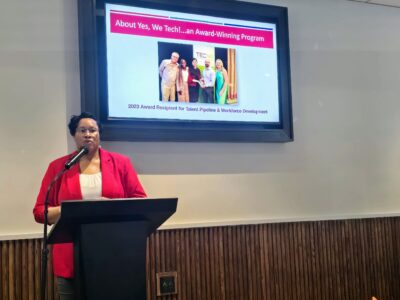As national press secretary for the Human Rights Campaign, the largest civil rights organization working for LGBTQ equality in the U.S., Sarah McBride is more than a bit of an expert on our editorial calendar the topic of the month: gender equity in the workplace.
McBride, a graduate of Cab Calloway School of the Arts, lives and works (remotely) in Wilmington, where she is currently running a campaign for state senator for the 1st District, which includes her home in The Highlands, Trolley Square, Bellefonte and Claymont. In 2016, she made a national name for herself as the first transgender woman to speak at the Democratic National Convention in Philadelphia. McBride is also the author of the book “Tomorrow Will Be Different.”
Technical.ly had a recent chat with McBride about gender equity in the workplace. Here’s what she had to say:
###
Technical.ly: What are some things employers can do to support gender equity in the hiring process?
Sarah McBride: I think the first thing, frankly, that’s critical in recruiting diverse talent, including people of every gender identity, is ensuring that you proactively take the steps to make your workplace safe and welcoming for all kinds of people. That means having clear non-discrimination policies; it means ensuring that, should you provide health insurance, your health insurance includes the varying needs of all your potential employees. It means adopting policies like paid family and medical leave that includes the range of different kinds of families and medical needs that your employees might have, including LGBTQ people and families.
Oftentimes they’ll start at the hiring process when we’re talking about recruiting diverse talent, but the reality is that it has to start before that. You can’t go out into the world and recruit diverse talent if you haven’t already taken the internal steps to ensure that they will have the policies, benefits and practices that they need to not just come to work, but to thrive at work.
How do employers create proactive policies?
The first foundational policy is making sure that they have clear equal employment opportunity policies that include gender, race, gender identity sexual orientation, religion, disability, national origin, et cetera. Those clear policies are really important to ensure that a person who is considering working at a particular company knows that the company has been intentional about saying, “We treat all of our workers and customers equally and fairly.”
At the Human Right Campaign, we did a study on LGBTQ workers that found that far too many LGBTQ people don’t have access to any kind of family medical leave policy, and when they do, too often it doesn’t include the kind of family structures that LGBTQ people exist in, or the medical needs of LGBTQ people, including transgender people. So paid family medical leave is critical in the broader question equity in the workplace, but make sure that those policies also explicitly include the full range of diversity within any given gender.
And then, more broadly, when we’re talking about gender equity, obviously transparency with pay is really important. Not asking about the pay history of the applicant is considered a best practice to ensure that people of all different backgrounds have a level playing field.
How does not asking about pay history help level the playing field?
Often times what will happen is that companies will end up lowballing someone based on having lower pay in the past. Compared to a male employee, for instance, who’s had a higher pay, it can compound and continue the pay equity issue. Unintentionally, even, subconsciously. It’s a growing practice.
Is that different from asking for salary range?
It’s different from asking salary range. It’s specific salary history that can give people a disadvantage in negotiations.
What should employers do to ensure that the health insurance they offer is equitable?
For transgender people, one of the most frequent forms of discrimination that they face is discrimination in health insurance. And that could include blanket exclusions that forbid coverage of what is considered medically necessary care, and to remove those blanket bans that target transgender people is really a critical part of recruiting trans talent.
Delaware has made a lot of progress. The insurance commissioner [in 2016] issued a bulletin that forbids blanket transgender exclusions — but some of those policies only impact certain forms of health insurance. But typically what can happen is the employer can very easily negotiate with the insurance provider to ensure that they do not include the blanket ban. Even if you’re an employer who’s insurance plan is governed by the bulletin by the Delaware insurance commissioner, you can take the next step of actually proactively affirmatively stating in the insurance in your annual negotiation that the insurance covers transition related care.
Let’s move from hiring to the workplace itself. Now that they’ve hired gender-diverse employees, how can an employer make sure it’s equitable day to day?
A lot of what we’ve talked about are some of the building blocks of building an inclusive workplace policy. The other components are making sure that there are regular diversity, equity and inclusion training that include all forms of gender bias training, all forms of LGBTQ bias training, to ensure that people are being proactively educated. Those types of programmatic steps are critical in building safe and affirming workplaces.
Similarly, making sure that the outward face of the entity, whether it’s a small business, a medium-sized business or a large business, reflects the diversity of not just the workplace but also the customer base they seek — the subtle pieces of building an inclusive workplace, and an inclusive business, and of frankly just getting a competitive edge of saying to that diverse client or customer base, “We look like you and we can serve people like you.”
Oftentimes people think that if they just put in the policies and practices everything will be OK. It’s important to recognize that this is an ongoing conversation, that no workplace is immune from prejudice or biases, because they exist in the broader world around us. Recognize that even small jokes or seemingly little comments can create a hostile work environment for a person of a different background or identity.
So recognizing the importance of the big programmatic and policy changes, but also the day-to-day quality of life, what kind of environment are you creating, what kind of model are you setting, and what will you tolerate? A lot of times, [employees] avoid speaking out against the jokes or comments that may unintentionally diminish the dignity of a coworker, but those are the types of comments and experiences that can lay the foundation for more tangible discrimination to occur.
There seems to be a big gap there in human resources sometimes. We’ve heard women of color speak about how if you file a complaint to HR about racial comments, they are often disregarded because they say there has to be proof of malicious intent. I imagine it’s no different with people of marginalized genders.
Definitely. What’s critical for HR departments to know is that intention doesn’t mitigate harm. That they have a responsibility to ensure that they combat any kind of behavior that makes an employee unsafe or unwelcome, and in many cases, that’s behavior that may be unintentional. A lot of people, particularly as we talk about the realization of the fuller diversity of our workplaces, there are going to be people who just aren’t aware, who don’t know what they don’t know. Which, again, goes to the importance of proactive training, right? To make sure that we’re educating our workforce so that we can diminish the mistakes and the harms by folks who don’t realize what they’re doing.
The reality is that unsafe workplaces are frequently created not by intentional malice but by ignorance. And we have to be comfortable as a society to step in when someone’s hurting someone else and be able to deliver the constructive feedback so that the person can course correct. And when they’ve been given the opportunity to course correct, they either course correct or, if they continue to do it after having been educated, that reveals intentionality and malice.
Another critical component of building workplaces that are inclusive of all women or people of every gender background is to recognize that gender exists within a multitude of different identities. Every employee wants to be able to bring their whole selves to work, and that includes their identities, not just around gender but around race and religion and family structure and life experience. All of these issues are inextricably linked with one another. You can’t build a workplace that’s safe for all women, or all LGBTQ people or all people of color without building a safe workplace for all of them.

This editorial article is a part of Technical.ly's Gender Equity in Tech Month of our editorial calendar.
Before you go...
Please consider supporting Technical.ly to keep our independent journalism strong. Unlike most business-focused media outlets, we don’t have a paywall. Instead, we count on your personal and organizational support.
Join our growing Slack community
Join 5,000 tech professionals and entrepreneurs in our community Slack today!





